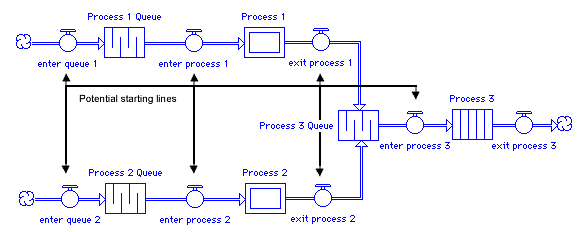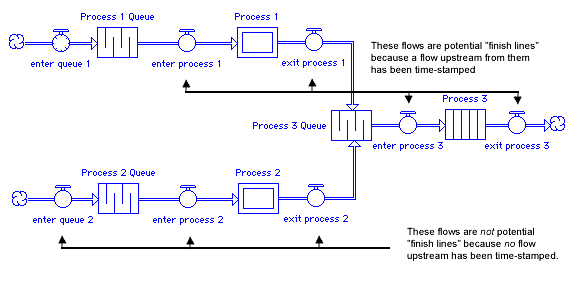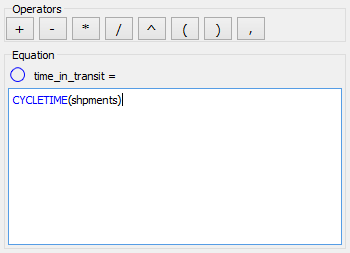
This section presents a process for incorporating cycle-time into your models. At its essence, the process is really simple. The process involves four basic steps:
Note: To use the cycle-time functionality you need to choose the integration method cycle-time for your model in your run specs.
Let's take a closer look at each step in the process.
1. Determine the starting line: In this step, you're deciding what flow(s) in the process should be considered the starting line, for the purpose of generating cycle-time metrics. Any flow in a conserved flow chain can be used as the starting line. In the following figure, for example, you could choose from a lot of potential starting lines. Any flows downstream from the starting line you choose can be used to generate cycle-time metrics.

So, if you identify the flows "enter queue 1" and "enter queue 2" as your starting lines, you can collect cycle-time data like the wait time for "process 1", the total time for "process 1", and the cycle-time for the overall process. Or, if you decide to use "enter process 3" as your starting line, the associated cycle-time calculation will only tell you about Process 3.
Notes: When you have multiple entry points to a main chain, you'll want to consider making each entry point a "starting line". In the previous figure, if "enter queue 1" is designated as a starting line, but "enter queue 2" isn't, only the material moving through the main chain via "enter queue 1" will be considered in the subsequent cycle-time calculation.
It's possible to designate successive stages in a main chain as starting lines. In the previous figure, for example, you might want to designate both "enter process 1" and "enter process 3" as starting lines. However, if both flows are time-stamped, material that moves through "enter process 1" will be time-stamped again, when it moves through "enter process 3". The material will lose its earlier time-stamping.
2. Time-stamp the flows
which represent the starting line: To time-stamp a flow, begin
by entering the Equation properties panel. As indicated in the following figure, you'll
find a check box next to a small stopwatch icon ![]() at the top right of the
panel. This check box is the time-stamping check box. Select the box. When you return to the diagram, the flow's appearance
will change to indicate that it's been time-stamped. An illustrative
time-stamped flow is also shown below.
at the top right of the
panel. This check box is the time-stamping check box. Select the box. When you return to the diagram, the flow's appearance
will change to indicate that it's been time-stamped. An illustrative
time-stamped flow is also shown below.

3. Determine the "finish line": The finish line is the point in the conserved-flow chain where you want to collect the cycle-time information. As shown below, the finish line can be any flow that's in the chain downstream of the starting line. There has to be a time-stamped flow upstream in the conserved flow chain, if cycle-time calculations are going to mean anything.

4. Tap into the flow associated with the finish line: To wrap up your work, you'll use a connector and a converter to tap into the finish line flow. You can define the converter using one of the cycle-time builtin functions. As illustrated below, this step is straightforward. When you finish, the converter will sport a partially-filled clock face. This is your visual indication that the converter is generating cycle-time data. Now, when you run your model, as the time-stamped flow volume crosses the finish line, its time-stamp will be used to generate the cycle-time data you want.

Notes: It's possible to tap into a conserved flow chain in multiple places, so you can collect cycle-time information from multiple stages in a conserved-flow chain. Each metric will be generated based on the closest upstream time-stamp.
By using multiple converters tapped into the same downstream flow, you can calculate a number of different cycle-time metrics at the same point in a process.
Cycle-time builtins are available only in converters. They'll be gray unless the converter is tapped into a flow in a conserved-flow chain, and you've time-stamped a flow somewhere upstream in the same conserved-flow chain.